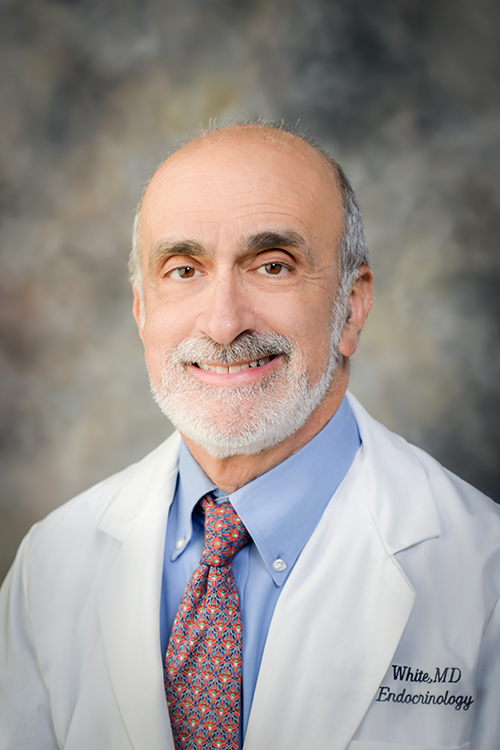

In January 2020, a young woman in her late teens was referred to Children’s Health℠ for complex congenital adrenal hyperplasia (CAH). Despite being on medication, she had visible signs of elevated androgen levels, such as severe acne on her face, chest and back. Lab tests would later reveal that she had very high levels of the steroid hormone 17-hydroxyprogesterone (17-OHP), putting her at risk for an adrenal crisis. She was also seeking a vaginoplasty to surgically create a vaginal opening, which she was born without, a common anomaly in these patients.
As one of only eight CAH Centers of Excellence nationwide, the center at Children’s Health is led by two renowned UT Southwestern physicians – Pediatric Endocrinologist Perrin White, M.D., and Pediatric Urologist Linda Baker, M.D. The center has a Level I designation by the CARES Foundation. 
“Our multidisciplinary team coordinated together to treat the whole patient – from adjusting her medication to providing psychological treatment and a cutting-edge surgical procedure,” Dr. White says. “We also facilitated a seamless transition to adult care, which included access to an experimental drug. Together, we were able to drastically improve her quality of life.”
The Risks of Uncontrolled CAH
This patient has classic 21-hydroxylase deficiency CAH, which means she’s unable to synthesize cortisol normally due to the missing enzyme. This leads the adrenal cortex to overproduce cortisol precursors, including 17-OHP.
“Normal levels of 17-OHP are 150 ng/dL. This patient’s levels were at 19,000 ng/dL,” Dr. White says. “She was prescribed Hydrocortisone, but it wasn’t effective, mainly because she was not receiving all of her prescribed doses.”
With the condition uncontrolled, the patient faced two major issues:
- Risk of adrenal crisis: If she were to get physically stressed, like from any infection, she could experience an adrenal crisis and require emergency medical care.
- Elevated androgen levels: This caused severe acne, excess facial and body hair, deepening of her voice and subsequent mental health issues.
Personalized Treatment and Patient Education to Better Control CAH
Hydrocortisone is used for children with classic CAH, particularly during their linear growth years. But it requires three doses per day, which can be difficult for any child or teen. For late teens who have reached maximum height, Dr. White often considers other medication regimens.
“Prednisone tends to be more appropriate for teens who have completed growth. And it’s also twice a day, so it’s easier,” Dr. White explains.
Dr. White also:
- Educated the patient and her family on the importance of each of her medications, and the improved outcomes she could expect if she received all of her doses.
- Referred the patient to the clinic’s psychologist to help with mental health issues that can negatively impact clinical outcomes. She received ongoing treatment, including motivational interviewing and cognitive behavioral therapy, to help with anxiety, depression, peer and familial relationships, body image and self-esteem.
The new treatment approaches helped reduce her 17-OHP levels to 2,000 ng/dL, significantly improving her symptoms and decreasing her risk of adrenal crisis.
Seamless Transition to Adult CAH Care and Pivotal Clinical Trial
When the patient turned 18, Dr. White saw an opportunity to help lower her 17-OHP levels even further and better control her condition.
Crinecerfont is an experimental drug that helps control CAH by suppressing abnormal androgen secretion. UT Southwestern is currently one of 22 sites nationwide and the only site in Texas enrolling adult CAH patients for this drug’s Phase III clinical trial.
“We collaborated with our adult colleagues at UT Southwestern to transition this patient into adult care, which included participation in this exciting study,” Dr. White says. “Crinecerfont is used in conjunction with a glucocorticoid, like Hydrocortisone and Prednisone, but it enables better hormonal control with lower doses of glucocorticoid drugs. Lower doses reduce side effects, like weight gain. This patient could have better control of hormone levels despite her stable regimen of Prednisone at a high dose, so she was ideal for this study.”
Cutting-Edge Surgical Procedure: Buccal Mucosa Vaginoplasty
Because CAH causes fetuses to be exposed to high levels of androgens, females are often born with atypical genitalia. This patient was born without a separate external opening for the urethra and vagina. Instead, she had a urogenital sinus that internally connected these two structures. She consulted with Dr. Baker about reconstructive surgery for a few reasons:
- She had an increased risk for urinary tract infections, which can cause CAH patients to have an adrenal crisis.
- She wanted the option to use sanitary products, like tampons, for menstruation.
- She was concerned about not being able to have Pap smears and other gynecological exams.
- She was interested in becoming sexually active and wanted a separate vaginal opening.
Dr. Baker is recognized nationwide as a leader in complex surgical treatments, including vaginoplasty and the innovative buccal mucosa technique. This technique involves harvesting the inner part of the cheeks for vaginal reconstruction.
“This patient had a more complex surgical case. Her urogenital sinus was really long and deep inside the body, which also meant she had a very short vagina without enough vaginal tissue to complete reconstruction,” Dr. Baker says. “The buccal mucosa technique is an alternative to skin grafts that I’ve found to provide the best outcomes. The tissue is the right color and texture, and it also doesn’t leave a visible scar.”
After the procedure, the patient recovered in the hospital for seven days with an inflatable device that supports the reconstructed vagina. She also did mouth exercises to help prevent any tightening inside the mouth that can occur after tissue is harvested from there. After the one-week stay, Dr. Baker helped her learn how to use a vaginal dilator and overcome any fear or nervousness. She had her follow-up appointment about two weeks after discharge.
“Our team extensively collaborated to help this patient achieve a healthier, happier future,” Dr. Baker says. “It’s incredible to see how drastically her quality of life has improved.”
Learn more about innovative care for pediatric endocrine disorders at Children’s Health >>